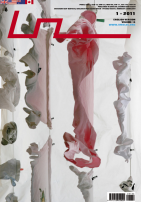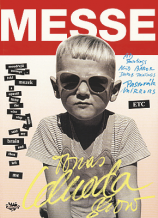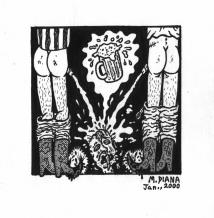| Umělec 2011/1 >> The sugar greek of music and the vain yearing for hierarchy | Просмотр всех номеров | ||||||||||||
|
|||||||||||||
The sugar greek of music and the vain yearing for hierarchyUmělec 2011/101.01.2011 Petr Ferenc | music | en cs de |
|||||||||||||
|
Sugar Creek was only two inches deep and fifty yards wide at the bend. Now they had put the Mildred Barry Memorial Center for the Arts there. It was beautiful. Sugar Creek flooded now and then. In a land so flat, flooding was a queerly pretty thing for water to do. Sugar Creek brimmed over silently, formed a vast mirror in which children might safely play. The mirror showed the citizens the shape of the valley they lived in, demonstrated that they were hill people who inhabited slopes rising one inch for every mile that separated them from Sugar Creek.
Kurt Vonnegut: Breakfast of Champions I. Any attempt at summarizing, on a few pages, the contemporary state of music is as Sisyphean an undertaking as trying to write a graduate thesis on the subject of “The Universe and Nearby Environs.” We will thus limit ourselves to a creek and – in order to avoid getting bogged down in trivialities – won’t name anyone. This text really is not interested in answering whether band A is better than band B or whether C is better than D. In a recent interview, a certain contemporary musician asked us to compare the distance music traveled between 1960 and 1970 with the distance it traveled between 2000 and 2010. The expansiveness and horizontality of Sugar Creek, the only watercourse in the “asshole of the universe,” provides an ideal addendum to his words. And, oh! That sweet name and the surprise awaiting any feet that are dipped in its waters! Music wants to have it all (this is how we see it, why we love it), wants to embrace and envelop, to drown, to provide pleasure, and to do so exclusively on the basis of feelings and associations, or through self-defensive gestures of an inexact “scientism.” But any attempts at taking the broader view reveal its depths to be as shallow as Sugar Creek. At least in Western society, music long ago ceased being rough and subversive, having become a medium for dreamlike projections, a kind of RPG for listeners. Any attempts at staking out a distinctly vertical position within the shallow horizontal mirror of Sugar Creek are as ludicrous as the inhabitants’ discovery that they are actually hill people. Any structure resembling a tower would end in a Babylonian confusion of languages, although it is far more likely that its builders–not knowing how to excavate an objective, existing foundation–would never even start construction. The only certainty we have with music or any other art is that it is in some way necessary. We may infer this conclusion from the fact that, in the history of mankind, there is no moment when it did not exist; in fact, a world without music would be the darkest anti-utopian vision, or at least an interesting futurological debate. But how to measure what is high art and what is low? The most objective yardstick today would appear to be commercial success–a criterion that many musicians, listeners, and critics reject on elitist grounds. They argue that not everyone is capable of recognizing true quality, that even most people who listen to music are incapable of doing so because this majority sees music as nothing more than entertainment. This “entertainment factor” demanded by the mainstream media may be tedious, but to snobbishly underestimate such music is just as much a distortion of reality as unreservedly adoring it. At times, the loathing exhibited towards the “invisible hand of the market” by supporters of the avant-garde is almost ludicrous, especially if by miracle this hand happens to pick one of their protégés. Then, they are capable of going on shamelessly about the triumph of justice, or they propound the theory of indirect proportionality: the more successful a band, the worse it is. II. Nobody will be surprised to hear that music isn’t everything. Just about everyone will agree with this notion, even though the same just about everyone has ears and has heard music that has meant nearly everything to him or her–it was important, meaningful. For some people, this meaning is associated with personal experiences (the two of us met when that song was playing), but for many others music is almost an epiphany: the first time I heard XXX, it changed my life, I decided to buy a guitar and... On the other hand, various self-appointed and non-self-appointed experts love to take refuge in defining the importance of music on the basis of historical meaning. The last living and singing castrato, the early days of dodecaphony, the first electronic composition, the father of rock ’n’ roll, the first Czech punk band, the father of dubstep... as if the spawn were more flavorful than the actual mushroom, as if those who crossed the finish line second and by various detours were not worth listening to. A similar danger is hidden inside the musician’s statement quoted at the outset of this article: that there was more going on in music in the 1960s than in the first decade of the new millennium. At first glance, there is no reason to disagree, although the musician in question was not active in music at the time, so it is possible that he is a victim of the growing distortion of the past. We could claim, however, that the 1960s (especially if we talk about rock music) were a period of joyful discovery during which the hand of the market was capable of better meeting artists’ and listeners’ yearning to discover something new than it is today. The best bands competed to see who would come out with the most revolutionary album, and these albums then made it into the Top 40. But what about the mass of unsuccessful artists, dilettantes and pioneers of dead-end streets? Judging an era only by the best and most successful certainly does not give us the whole picture. The reason we view music today like Sugar Creek–flat and two-dimensional–is the internet, whose democratic nature has increased access to information. Any blogger or anyone who has ever downloaded something can be an expert. It has never been easier to get our hands on a recording we are interested in, meaning that the seal of exclusivity (an LP from the West, illegal street-vendors–to restrict ourselves to the local scene) has practically ceased to exist, limited only to a small circle of fetishist collectors. The fact that we no longer look up to an enlightened caste of experts has put an end to the glorification of the critic and the deification of his opinions. Imagine an Adorno in the time of online discussions… Undoubtedly, we would all agree that nobody could possibly reflect critically upon all the music in the world. Nevertheless, more than a few music editors and reviewers try to do just that: to give us the impression that they can, to erect a tower of importance in Sugar Creek. Without exception, they are all narrow specialists lacking a broader view: the creek’s morphology does not allow the creatures living in it to see the world from above the surface. As a result, the creek is full of tiny colonies that can see no further than their immediate neighbors, meaning that they know of the more distant colonies only from the inaccurate reports of ‘wise men’–but is the old man who is considered to be wise within one colony automatically wise under the neighboring rock? Better not to find out: what if it proved not to be true… And so, like everyone else, I offer only my view of contemporary music, a view limited to (by) those few areas that I am familiar with. III. At the beginning of the new millennium, both contemporary popular music as well as so-called “independent” music were affected by an important technological breakthrough: the emergence of computers (in particular the Apple laptops) as tools capable of improvisation. If we can speak of a musical “style,” it is distinctly eclectic and whimsical, something like fashion (new spring and autumn styles, big hits of the coming season, and so on), and tends to take a schizophrenic attitude–a feeling of satisfaction and shame–to this fact. One general trend is retro, but not all forms of retro: You have to be careful in selecting which past to return to in order to avoid ending up with a part of history that is currently “out.” The aim is not any objectively definable “quality”–as shown by the frequent use of the phrase guilty pleasures to describe music that the listener is embarrassed to admit liking but which he nevertheless enjoys and happily talks about in fits of perverse confession. Music journalists love all this looking back to the past because it allows them to show off their wisdom while pointing out linkages, connections, intersections–how things relate to other things. Anything new and not previously heard is likely to be overlooked, since the minds of the wise men are attuned to something else, namely digging in the archives. The result of all this self-gratification is the pubescent search for fellow sinners, since it is more fun in twos or threes. Man is a social animal, and shared sins are not a burden but give him wings. As we have said before, a place like Sugar Creek is the perfect place for people to associate in small, self-defining, and self-confirming communities. IV. Any community or association, in particular when involved in promoting the healthy growth and prosperity of our favorite type of music, necessarily leads us to the question of government-funded music (or art). The proponents of this or that music scene, artist, or style often fight for subsidies based on the argument that civilization itself will collapse if the monies are not dispersed in a fair manner. The enlightened, humanist, civilized state doles out subsidies. Occasionally, it is aware of the importance of tradition; at other times, it emphasizes current trends or calculates how it might profit from its towns being considered cultural metropolises. But anti-utopian scenarios of what might happen if the funding is not delivered into the rights hands are sheer hyperbole, a mental construct that both sides accede to, aware of the fact that their dialogue takes place in the form of exaggerations, metaphors, and allegories. What would happen if the government were to suddenly cease playing this game? Would the world collapse with the death of one philharmonic orchestra or one festival dedicated to the latest electronic music? Many people, in particular those from one or the other underground movement, believe that authentic, living art can survive even without government funding and that an artist who feels within himself the need to say something will do so under any conditions. Sure, this is most true for alternative bands or solo projects, but the situation is not so good for music venues and magazines or for music that requires the artists’ full-time commitment. Some help might come from private philanthropists or community support (for instance, a band’s fans might pay for it to release an album), but without government support the musical map of the world would definitely look dramatically different. It is certainly appropriate to ask whether art that is dependent on the state can be called “living” or “viable.” Perhaps such art is merely on “life support.” But in a humane world opposed to euthanasia it would be immoral to just pull the plug even if a particular type of art doesn’t strike us as important or economically useful. V. After all this cynicism, let us return to the concept of importance. Of course music possesses a true importance–the first mentioned in this text: subjective importance. Only subjective importance is pure and incontestable. Any attempt at generalizing contains the seeds of dictatorship: either the cultural terror of the proponents of “high art” or in the form of sterile trends and fashions. Not only does music yearn to embrace and envelop, to provide pleasure, to invoke contemplation or help release pent-up energy (etc. etc.), despite all that we have said above, it manages to do so with refinement and gentility. But it does so exclusively in the mind, spirit, and body of the individual. All attempts at mediating this experience en masse, at preaching and dictating taste–whether from above (from intellectuals) or below (on the basis of sales, which are objective and nothing else)–have merely limited music’s possibilities. I admit that in a debate on universalisms, I would tenaciously defend the superiority of individual taste. With such an imprecise and abstract discipline as music (and this relates even to dodecaphony or spectralism or electronic music requiring the genius of an IT expert), I just cannot imagine imposing my opinions on others. Or rather: Of course I do so gladly and passionately, but this manic zealousness that forms an inseparable part of the life of any music lover is consciously subjective. The inner, personal reasons that led me to enjoy one particular type of music and to reject other types are impossible to describe. I am convinced that music has something to say if it is a dialog between an artist who has something to say and a listener who knows how to listen–not a stadium spectacle involving a mass of artists and an anonymous mob. One wise guy in some magazine once said that there are as many sexual perversions in the world as there are people. I am convinced that this equally applies to man’s relationship to music, and that, however important they may be, any attempts at generalizing this relationship, whether in this article or in the form of a screaming mob of people at their favorite musicians’ concert, will always be misleading. VI. Postscript: I love music that makes me feel as if its makers were speaking directly to me. I love musicians who stand out from the crowd and who don’t hide behind the protective screens of scenes and collectives. I love artists who can take the broad view, who have their doubts regarding Sugar Creek even though they love it to the core and are formed by it just as much as the character in Vonnegut’s book. There were no bridges across the creek. He would have to wade. So he sat down on a guardrail, removed his shoes and socks, rolled his pantlegs to his knees. [He] lowered his artistic feet into the concrete trough containing Sugar Creek. They were coated at once with a clear plastic substance from the surface of the creek. When, in some surprise, Trout lifted one coated foot from the water, the plastic substance dried in air instantly, sheathed his foot in a thin, skin-tight bootie resembling mother-of-pearl. He repeated the process with his other foot. He knew how ridiculous he looked. He expected to be received abominably, dreamed of embarrassing the Festival to death. He had come all this distance for an orgy of masochism. He wanted to be treated like a cockroach.
01.01.2011
Рекомендуемые статьи
|
|||||||||||||
|
04.02.2020 10:17
Letošní 50. ročník Art Basel přilákal celkem 93 000 návštěvníků a sběratelů z 80 zemí světa. 290 prémiových galerií představilo umělecká díla od počátku 20. století až po současnost. Hlavní sektor přehlídky, tradičně v prvním patře výstavního prostoru, představil 232 předních galerií z celého světa nabízející umění nejvyšší kvality. Veletrh ukázal vzestupný trend prodeje prostřednictvím galerií jak soukromým sbírkám, tak i institucím. Kromě hlavního veletrhu stály za návštěvu i ty přidružené: Volta, Liste a Photo Basel, k tomu doprovodné programy a výstavy v místních institucích, které kvalitou daleko přesahují hranice města tj. Kunsthalle Basel, Kunstmuseum, Tinguely muzeum nebo Fondation Beyeler.
|
































 New book by I.M.Jirous in English at our online bookshop.
New book by I.M.Jirous in English at our online bookshop.
Комментарии
Статья не была прокомментированаДобавить новый комментарий